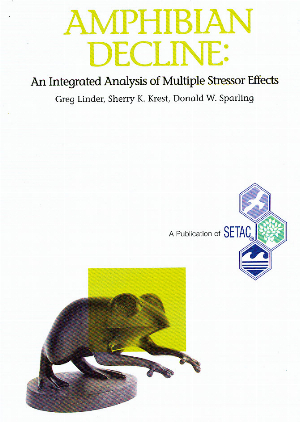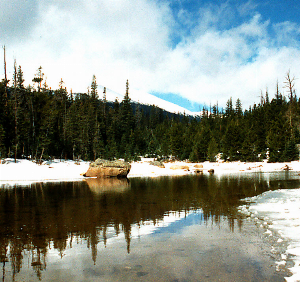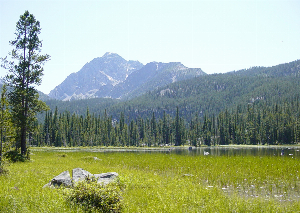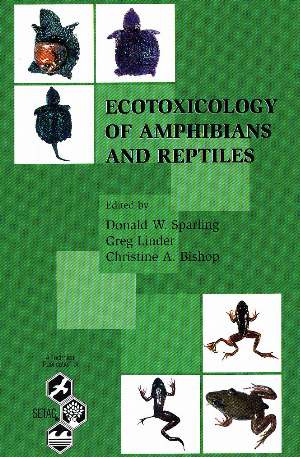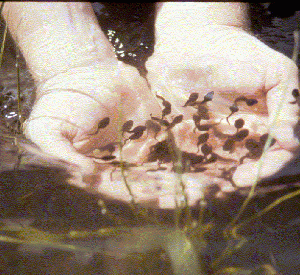Search ARMI Database
Search term(s)
Contribution Number
Search Results
70 record(s) found.
Papers & Reports Deteriorating status of western amphibians: can we generalize about causes?
Authors: P. Stephen Corn
Date: 2003 | Outlet: Linder G, Krest SK, Sparling DW, editors. Amphibian decline: an integrated analysis of multiple stressor effects. Pensacola, FL: Society of Environmental Toxicology and Chemistry 249–255
Regardless of whether amphibian declines are due to single or multiple causes, conservation efforts in the future will need to consider multiple stressors in most cases.
Papers & Reports Amphibian breeding and climate change: the importance of snow in the mountains
Authors: P. Stephen Corn
Date: 2003 | Outlet: Conservation Biology 17: 622–625
The breeding phenologies of ectotherms are inextricably linked to weather, and amphibians in some temperate locations may have been breeding earlier in recent years in response to warmer spring temperatures.
Papers & Reports Amphibians and wilderness
Authors: P. Stephen Corn
Date: 2001 | Outlet: International Journal of Wilderness 7(2): 25
Diversity of amphibians varies among wildernesses, from high in the Southeast to low in high-elevation Wilderness Areas and backcountry areas of National Parks in the western United States. Knowledge about the status of amphibians is important, because amphibians occupy important ecological niches and a high proportion of western amphibian species have undergone recent declines, often in protected habitats.
Papers & Reports A plague of frogs: the horrifying true story
Authors: P. Stephen Corn
Date: 2001 | Outlet: Quarterly Review of Biology 76: 64–65
Book Review - The book is written with little technical jargon and should be accessible to any biologically literate, nonprofessional reader. I also recommend this book to professional audiences, including undergraduates and early graduate students who still harbor illusions that science proceeds the way it is described in textbooks
Papers & Reports Amphibian declines: review of some current hypotheses
Authors: P. Stephen Corn
Date: 2000 | Outlet: Sparling DW, Bishop CA, Linder G, editors. Ecotoxicology of amphibians and reptiles. Pensacola FL: Society of Environmental Toxicology and Chemistry 663–696
The documented and hypothesized causes of declines in amphibian populations fall into three categories: habitat destruction and alteration. global anthropogenic influences, and natural causes. I will not review all of these in detail because some are the subjects of other chapters in this volume. I will discuss effects of introduced predators and increasing ultraviolet radiation more thoroughly because these factors represent extremes in our ability to explain and possibly reverse declines.
Papers & Reports Factors limiting the recovery of boreal toads (Bufo b. boreas)
Authors: C Carey; P. Stephen Corn; M S Jones; L J Livo; Erin Muths; C W Loeffler
Date: 2005 | Outlet: Lannoo M, editor. Amphibian declines: the conservation status of United States species. Berkeley: University of California Press 222–236
Book chapter that discusses specific limitations to the recovery of boreal toads from population declines in Colorado.
Papers & Reports Sensitivity to acidification of subalpine ponds and lakes in northwestern Colorado
Authors: D H Campbell; Erin Muths; J T Turk; P. Stephen Corn
Date: 2004 | Outlet: Hydrological Processes 18: 2817–2834
The chemical composition of 97 lakes and ponds in and near the Mount Zirkel Wilderness Area (MZWA) was studied during snowmelt of 1998 and 1999 to determine the magnitude of episodic acidification and the effects of acidification on amphibian reproductive success. Within the areas identified as sensitive to acidification based on granitic bedrock types, there was substantial variability in ANC that was likely related to differences in hydrologic flowpaths that control delivery of weathering products to surface waters. Many of the lakes are sensitive to acidification (summer and fall ANC< 100 &#61549;eq/l), however, none of them appeared to be immediately threatened by episodic or chronic acidification. 22 ponds had minimum ANC of < 30 ueq/l, indicating that they are extremely sensitive to acidic deposition, however net acidity (ANC < 0) was not measured in any of the ponds. The lowest measured pH value was 5.4 and pH generally remained less than 6.0 throughout early summer in the most sensitive ponds, indicating that biological effects of acidification are possible at levels of atmospheric deposition measured during the study.
Papers & Reports Spatial and temporal variability in the amount and source of dissolved organic carbon: implications for UV exposure in amphibian habitats
Authors: Paul D Brooks; C M O’Reilly; S Diamond; D H Campbell; Roland A Knapp; David F Bradford; P. Stephen Corn; Blake R Hossack; K A Tonnessen
Date: 2005 | Outlet: Ecosystems 8: 478–487
The amount, chemical composition, and source of dissolved organic carbon (DOC), together with in situ ultraviolet (UV-B) attenuation, were measured at 1–2 week intervals throughout the summers of 1999, 2000, and 2001 at four sites in Rocky Mountain National Park (Colorado). Eight additional sites, four in Sequoia and Kings Canyon National Park/John Muir Wilderness (California)and four in Glacier National Park (Montana), were sampled during the summer of 2000.
Papers & Reports Physical stressors
Authors: Michelle D Boone; P. Stephen Corn; M A Donnelly; E E Little; P H Niewiarowski
Date: 2003 | Outlet: Linder G, Krest SK, Sparling DW, editors. Amphibian decline: an integrated analysis of multiple stressor effects. Pensacola, FL: Society of Environmental Toxicology and Chemistry 129–151
Our objectives in this chapter are to 1) review current information on physical stressors on amphibian population declines, 2)address the roles that changes in the physical environment could play in amphibian declines, 3) make predictions about the effects of physical stressors, and 4) determine what information is needed to evaluate the effects of physical stressors on amphibian populations.
Papers & Reports Distribution patterns of lentic-breeding amphibians in relation to ultraviolet radiation exposure in western North America
Authors: Michael J Adams; Blake R Hossack; Roland A Knapp; P. Stephen Corn; S Diamond; P Trenham; D Fagre
Date: 2005 | Outlet: Ecosystems 8: 488-500
An increase in ultraviolet-B (UV-B) radiation has been posited as one potential factor in some amphibian population declines. This hypothesis has received support from laboratory and field experiments showing that current levels of UV-B can cause embryo mortality in some species, but little research has addressed whether UV-B is influencing the distribution of amphibian populations. We compared patterns of amphibian presence to site-specific estimates of UV-B dose at 683 ponds and lakes in Glacier, Olympic, and Sequoia-Kings Canyon National Parks. All three parks are located in western North America, a region with a concentration of documented amphibian declines. Site-specific daily UV-B dose was estimated using modeled and field-collected data to incorporate effects of elevation, landscape, and water column dissolved organic carbon. Of the eight species we examined (Ambystoma gracile, Ambystoma macrodactylum, Bufo boreas, Pseudacris regilla, Rana cascadae, Rana leuteiventris, Rana muscosa, Taricha granulosa), two species (T. granulosa and A. macrodactylum) had quadratic relationships with UV-B that could have resulted from negative UV-B effects. Both species were most likely to occur at moderate UV-B levels. Ambystoma macrodactylum only showed this pattern in Glacier National Park. Occurrence of A. macrodactylum increased as UV-B increased in Olympic National Park despite UV-B levels similar to those recorded in Glacier. We also found marginal support for a negative association with UV-B for P. regilla in one of the two parks where it occurred. We did not find evidence of a negative UV-B effect for any other species. Much more work will be necessary to determine if UV-B, either alone or in concert with other factors, is causing widespread population losses in amphibians.

